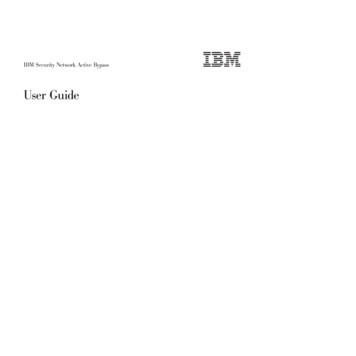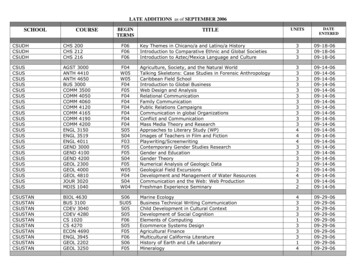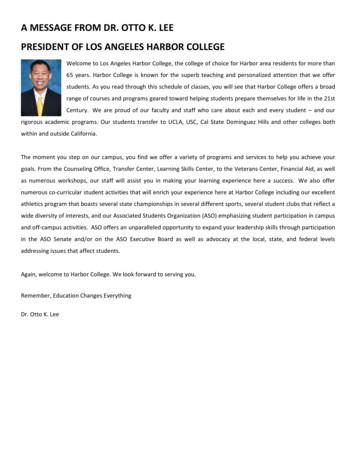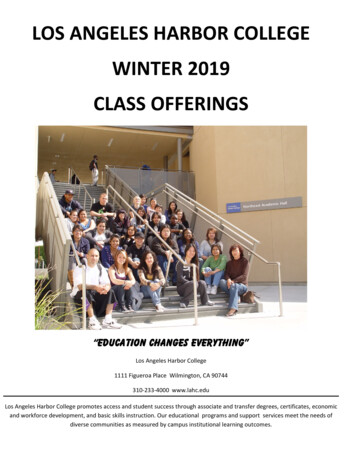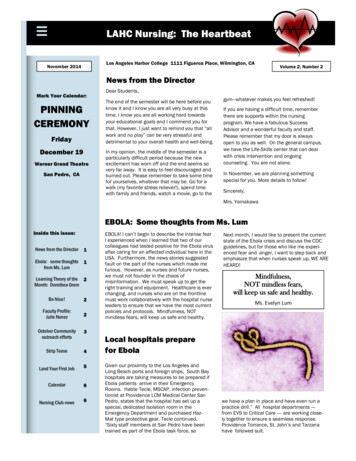
Transcription
LAHC Nursing: The HeartbeatLos Angeles Harbor College 1111 Figueroa Place, Wilmington, CANovember 2014Volume 2, Number 2News from the DirectorMark Your Calendar:PINNINGCEREMONYFridayDecember 19Warner Grand TheatreSan Pedro, CADear Students,The end of the semester will be here before youknow it and I know you are all very busy at thistime. I know you are all working hard towardsyour educational goals and I commend you forthat. However, I just want to remind you that “allwork and no play” can be very stressful anddetrimental to your overall health and well-being.In my opinion, the middle of the semester is aparticularly difficult period because the newexcitement has worn off and the end seems sovery far away. It is easy to feel discouraged andburned out. Please remember to take some timefor yourselves, whatever that may be. Go for awalk (my favorite stress reliever!), spend timewith family and friends, watch a movie, go to thegym—whatever makes you feel refreshed!If you are having a difficult time, rememberthere are supports within the nursingprogram. We have a fabulous SuccessAdvisor and a wonderful faculty and staff.Please remember that my door is alwaysopen to you as well. On the general campus,we have the Life-Skills center that can dealwith crisis intervention and ongoingcounseling. You are not alone.In November, we are planning somethingspecial for you. More details to follow!Sincerely,Mrs. YamakawaEBOLA: Some thoughts from Ms. LumInside this issue:News from the Director 1Ebola: some thoughts 1from Ms. LumLearning Theory of the 2Month: Dorothea OremBe Nice!2Faculty Profile:Julie Nunez2October Communityoutreach efforts3Strip Tease4Land Your First Job5Calendar6Nursing Club news6EBOLA! I can’t begin to describe the intense fearI experienced when I learned that two of ourcolleagues had tested positive for the Ebola virusafter caring for an affected individual here in theUSA. Furthermore, the news stories suggestedfault on the part of the nurses which made mefurious. However, as nurses and future nurses,we must not founder in the chaos ofmisinformation. We must speak up to get theright training and equipment. Healthcare is everchanging, and nurses who are on the frontlinemust work collaboratively with the hospital nurseleaders to ensure that we have the most currentpolicies and protocols. Mindfulness, NOTmindless fears, will keep us safe and healthy.Next month, I would like to present the currentstate of the Ebola crisis and discuss the CDCguidelines, but for those who like me experienced fear and anger, I want to step back andemphasize that when nurses speak up, WE AREHEARD!Mindfulness,NOT mindless fears,will keep us safe and healthy.Ms. Evelyn LumLocal hospitals preparefor EbolaGiven our proximity to the Los Angeles andLong Beach ports and foreign ships, South Bayhospitals are taking measures to be prepared ifEbola patients arrive in their EmergencyRooms. Habte Tecle, MSCAP, infection preventionist at Providence LCM Medical Center SanPedro, states that the hospital has set up aspecial, dedicated isolation room in theEmergency Department and purchased HazMat type protective gear. Tecle continued,“Sixty staff members at San Pedro have beentrained as part of the Ebola task force, sowe have a plan in place and have even run apractice drill.” All hospital departments —from EVS to Critical Care —- are working closely together to ensure a seamless response.Providence Torrance, St. John’s and Tarzanahave followed suit.
Page 2LAHC Nursing: The HeartbeatDorothea Orem:Self Care Deficit TheoryBOTTOM LINE: independence rocks!Dorothea Orem,MSN, RN1914-2007“The central philosophy of the Self-CareDeficit Nursing Theory is that all patientswant to care for themselves, and they areable to recover more quickly andholistically by performing their own selfcare as much as they're able. This theoryis particularly used in rehabilitation andprimary care or other settings in whichpatients are encouraged to beindependent. If a patient is unable tomeet their self-care requisites, a "selfcare deficit" occurs. In this case, the patient's nurse steps in with a supportmodality which can be total compensation, partial compensation, or educationand support.” 2013, http://www.nursing-theory.orgYou’ll be more successful in nursing school if you’re nice.A 2014 study reported inNursing Education Perspectivesnotes that there are severalstrategies that helped a groupof nursing students at University of Memphis/LoewenbergSchool of Nursing graduatesuccessfully. The top six:DAILY ROUTINE: a study ritualthat develops into a habit improves study skills, consistency,organization and confidence.Create a program (“two hoursof reading a night, followed by15 Kaplan questions”) andstick with it at least 3 to 4 daysa week.PEER STUDY GROUPS: if youdon’t “get it”, someone will.READING COURSE CONTENT:don’t just go over the Powerpoint slides and notes given bythe teacher.NOTE CARDS: visual learnersespecially profit from this tactic;take ’em with you wherever yougo and study at the bus stop.STUDENT SUPPORT: could it bethat Mom was right? PLAYNICE! “Peer supportive behaviors include interactions withother students that increasefeelings or inclusion and help inunderstanding of nursing content” (Dapremont, 2011).Being supportive of otherscreates a generally positiveatmosphere which in turn,supports success.FACULTY SUPPORT: if teachersare approachable, understanding and encouraging, it helps.Duh.Faculty Profile: Julie Nunez, RN, BSN, MAHave you noticed howvery clean, organized andattractive our NLL andcourtyard are? You canthank our newNURSING INSTRUCTIONALASSISTANT,Julie Nunez, RN, BSN, MA.Julie Nunez, RN, BSN, MAEducation ADN: LAHC, 1987BSN: University of Phoenix,2001MA in Bioethics: Loyola, 2009Previous experience: NICU,ambulatory, community andhospitalized pediatrics,Partners for Healthy Kidsmobile peds clinic; also homehealth and hospice, palliativecare and pain management .Hobbies: “I like to dig in thedirt.” In addition to growingroses, plumeria and bulbs of allkinds, Ms. Nunez also makesjewelry and loves to travel.“The best vacation? Ziplining inCosta Rica over the forestcanopy. Unforgettable.”Words of Wisdom: “Never, everEVER give up.”
Volume 2, Number 2Page 3LAHC Nursing Students work community health; October 2014Above, the flu shot clinic at Harbor UCLA.L to R: 2nd semester student Breanna Barrios vaccinates formerLAHC RN graduate Jackin Conlin; instructor Kathy Vo bravelyoffers her arm for Kurt Kuizon (2nd Semester); and Kurt gets hisfrom Brittany Vattuone.Left, Breast Cancer AwarenessLiz Waddell and Aleah Baklenko report: “We had a great day atthe Seahawk Center! The breast self exam sheets were greatand we had many sign ups and interest for the Nursing Club.”L to R: Angelo Almonte, student worker Camille Barrera, LizWaddell, Christina Rodriguez, Mrs. Nunez, Aleah Baklenko.Below, Providence LCM Med Center San Pedroflu shot clinicWHO GETS WHAT?About flu vaccinations bothintramuscular and intranasal routes offer about the same level ofprotection, but some people are better suited for the shot, whileothers do better with the spray.LAIV live attenuated influenza vaccine, FluMistPROS: The live virus vaccine is quadrivalent (4 different flu strains)and the intranasal route is perfect for those who don’t like injections.It’s suitable only for healthy folks, though, from ages 2 to 49 and notfor pregnant women.CONS: The virus has been weakened, but it’s still live. Kids under 2who received Flumist showed a significant increase in hospitalizations and asthma exacerbations. There’s also a chance the newlyimmunized will shed live virus, so Health-care personnel who care forseverely immunocompromised persons should receive inactivated,not live. Don’t give it to patients who are ill with fevers.IIV inactivated influenza vaccine, FluzonePROS: This dead virus, trivalent vaccine is OK for everyone over age6 months including pregnant women and folks with diseases. It’salso fine to administer if patients are currently ill, so they can beimmunized in the hospital.CONS: Don’t take if allergic to or objections about thimerasol(mercury derivative) preservative. The pediatric version of the deadvirus vaccine does not have thimerasol, which is a response todropping immunization rate due to parent concerns.Ruuskanen, O., Lahti, E., Jennings, L.C., Murdoch, D.R. (2011, April). Viral pneumonia. The Lancet, 377, 1264-1275.;Immunization schedules. (2013). Centers for Disease ControlRetrieved from d/0-18yrs-schedule-landscape-chart.pdf
FAILURE TO SENSE, PACEMAKER FAILURE: note the pacemaker “spikes” and consequent cardiac electrical capture, and then thethree spikes without capture. The pacemaker is working (spikes) but not always stimulating the heart muscle, which can causedecreased cardiac output. Possible causes include inadequate stimulus from the pacemaker, lead dislodgement, wire fracture orelectronic insulation break, catheter malposition, battery depletion, or myocardial ischemia. Indications for a permanent pacemaker include symptomatic bradycardias and heart block; he already has a pacer placed but obviously something is wrong witheither it or the heart. Pacemakers have improved markedly through the years, and although they need to be monitored, expectedbattery life varies between 4 and 10 years. In this case, you’d definitely call the doc and might be instructed to get a stat 12 leadEKG, portable chest X-ray and to turn the patient to the left side to float any loose internal electrodes against the cardiac wall. Thegenerator or battery might need to be replaced. Brunner and Suddarth, 2010You’ve just received report from the ED nurse on Mr. Hansen, a 82 year old man with an exacerbation of heartfailure. He has multiple stents and a pacemaker. While hooking him up to telemetry, you note he is wide awakeand alert; he tells you the reason he is sitting straight up in bed is because he “can’t seem to catch his breath”.You note fine bibasilar lung crackles and 3 pitting pedal edema. His BP is 140/94, and his radial pulse is 54and irregular, so you check the telemetry monitor to see what’s going on electrically with his heart .Strip Tease: can you figure out this rhythm?enjoy a smoothie in our nursing courtyard last month. We hope that you enjoyed the yummysmoothies and were able to take a break from the hustle and bustle of your courses for just amoment. Thanks to Mrs. Brust and Ms. Nunez for all their hard work in making this event asuccess! Three different flavors of smoothies and fresh fruit . wow!Smoothies for Success!Thanks to all the students who came out to
Another new addition toour faculty “family”.Mrs. Yamakawa writes, “I am excitedto introduce our new nursing TransferCounselor, Christine Kourinian.She is a General and InternationalCounselor here at LAHC so she is veryfamiliar with our students and college.“She will be here 3 hours a day, Monday through Thursday, in office # 137.She will work at fulfilling the goals andobjectives that we identified in our Song-Brown Special Project grant: to develop pathways with highereducation nursing programs; to disseminate information to students via transfer fairs, workshops, writtenmaterials; and to develop a transfer educational plan for each of our nursing students. “ Ms. Kourinianisn’t pictured above with this good looking group, but will be featured next month in our Faculty Profile!LAND YOUR FIRST RN JOB: TIPS FROM EXPERTS4th semester students Harmony McGehan and Juan Guerrero ablyrepresented LAHC at the California State Student Nurse Convention inPomona. Below is Harmony’s report:“To Infinity andBeyond! Limitlessopportunities fornursing students”:this was thetheme of theCaliforniaStudents'Association'sState Conventionheld in Pomona,CA on SaturdayOctober 18, 2014.The conventionhall was filled with electric and hopeful nursing studentsfrom all over the state. There were many speakers butone thing that was weighing heavily on everyone's mindwas landing their first job. Where is the best area to finda job as a new graduate RN in California? The CentralValley has an 80% hiring rate of new graduates. The Central Valley include the cities: Bakersfield, Fresno,Modesto, and Stockton. There are two states that arehiring the most California new RN graduates: Texas andFlorida.Brenda Brozek, MAOL, RN author of You're Hired! ANurse's Guide to Success in Today's Job Market spoke atthe convention. She stated that nursing recruiters spend10-30 seconds viewing an application and she suggestsusing action verbs such as "I supervised" and "I created" tocatch their attention. She recommends makingnursing student business cards and business cards aftergraduation and having them ready at career fairs andconferences to improve possible networking.After an application is filed with a hospital she has moretips. Check to make sure the voicemail the employer isgoing to reach sounds professional. Answer all phone callsbecause it could be a nursing recruiter on the other endcalling to do a screening interview. A screening interview isoften unannounced and is common practice at manyhospitals. This is done before to determine if they wouldlike a formal interview. A common question is "tell meabout yourself" on these calls so it is best to have a response thought out. She recommends carrying a smallnotebook with your resume folded inside and a list ofevery hospital and position applied for so the informationis ready when they call.Oh, and another tip for ladies! Leave the heels at homeand wear closed-toe flats to the interview. Many timeswhen they hire a new graduate RN, a tour of their prospective unit is given that day. This is done before todetermine if they would like a formal interview.
LAHCHealth Sciences1111 Figueroa PlaceWilmington, CA 90744Phone: 310-233-4282Fax: 310-233-4609E-mail: brustkt@lahc.eduThe mission of the Associate DegreeNursing Program at LAHC is to educate and prepare a diverse body ofstudents to become safe, competent, and caring Registered Nursesfor entry‐level positions in community health‐care settings while cultivating professionalism, an appreciation for other peoples and cultures,and a desire for life‐long learning.To achieve this mission, we strive tocreate a culture of excellence andsupport, where students are challenged to meet high educationalstandards.NOVEMBER CALENDARTuesday November 11 Veteran’s DayLAHC offices and NLL closedSunday November 23Last day to drop a full term class with a “W” onlineThursday November 27 Thanksgiving holidayLAHC offices and NLL closedFriday November 28 some clinical rotations areopen, so check with your instructorDecember 15—19:December 21:February 9:Final exam week:Last day of classes 2014Back to school!NURSING CLUB NEWSby Aleah Baklenko, 4th semesterThe campus Nursing Club is being rechartered this semester and will provideopportunities for LAHC's pre-nursingstudents and current nursing students toconnect through community outreachopportunities like flu clinics, first aidstations, blood drives and feeding thosein need.The Nursing Club helps pre-nursingstudents meet and ask questions ofcurrent nursing students about LAHC’sRegistered Nursing program; there is afocus on serving the community throughvarious events and staying informed ofcurrent topics in nursing. Meetings will beheld the second Monday of the month.Upcoming Events include:November 3-14: Help support the Nursing club’s canned food drive! Drop your donation in the marked box inNursing BuildingDecember 10: Serve at the YMCA San Pedro Better Breathers Club’s holiday luncheon
San Pedro, CA Los Angeles Harbor College 1111 Figueroa Place, Wilmington, CA November 2014 Volume 2, Number 2 Inside this issue: News from the Director 1 Ebola: some thoughts from Ms. Lum . 15 Kaplan questions") and LAHC Nursing: The Heartbeat Page 2 Dorothea Orem, MSN, RN 1914-2007


